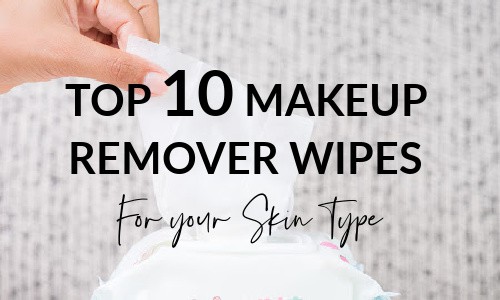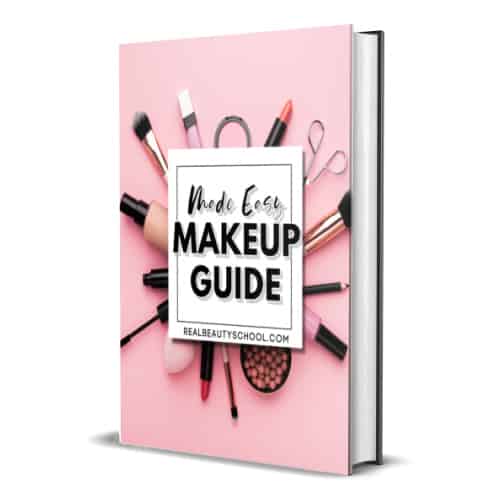Should Concealer be Lighter than Foundation?
Concealer. This tiny bottle is an essential part of every makeup routine, and yet, many people do not know enough about concealer to use it properly.
There are so many concealer mistakes that are so easy to make, and they might leave wanting to swear off concealer altogether.
But don’t worry! Once you understand how to use concealer best and find the best one for you, that small bottle will become your best friend.
That is why today we are talking about all things concealer and foundation, including which shade is best for you, how you can use concealer to highlight and/or contour and how to combine it with your foundation shade, and all of the benefits that concealer brings to the table!
Whether you are on the fence about concealer, or you are dying to learn some new concealer tips and tricks, keep reading!
This post may contain affiliate links. That means if you click and buy, I may receive a small commission (at zero cost to you). Please see my full disclosure policy for details.

Concealer Lighter than Foundation: The Basics
Before we dive into concealer specifics, I first want to break down exactly what concealer is, and why it is a beneficial product to own and incorporate into your makeup routine.
What is Concealer?
Oftentimes concealer and foundation get mixed up, as they both are used to conceal facial impurities, but there are a few key differences between the two.
- Thickness: Concealer is formulated a bit thicker than foundation.
- Amount: With concealer, less is more. While you can apply foundation to your entire face, concealer should be used more sparingly.
- High-Coverage: Since concealer is thicker, it will usually have better coverage than your foundation, which is why it is best to blend it into the problem areas of your face.
- Color Corrects: Most foundations do not color correct, but there are some concealers that are specifically designed to color-correct your skin! This can help reduce the look of redness, or heavy shadows.
What we want to achieve by wearing Concealer Makeup
Concealer is not just a one-trick pony. There are actually several different ways you can use concealer to upgrade your makeup routine.
Blur Lines: As your skin starts to mature, fine lines are inevitable. Luckily, concealer is the perfect product to blur your fine lines and make your skin look more youthful.
Highlight: I love using concealer as a highlighter. I will dive more into exactly how to use concealer as a highlighter, but for now, keep in mind that concealer is perfect to highlight your cheekbones!
Contour: It’s hard to believe that concealer can highlight and contour, but if you pick out the right shades, this one product can do both! If you love contouring and you haven’t tried contouring with a concealer, I recommend giving it a try! It is a game-changer.
Conceal: As the name suggests, concealer is perfect for concealing any blemishes. This includes acne, dark spots, discoloration, and more!
Prime Lids: You can also use concealer to prime your eyelids for whatever eyeshadow look you desire. This is the perfect way to create an even base for your eyeshadow look.
Look More Awake: Concealer can also hide those less-than-desirable under-eye circles, which will make you look more awake and alert!
Should Concealer Be lighter than Foundation?
Concealer should be lighter than your foundation only if you are applying it to bring light to certain areas like under the eyes, chin, middle of your forehead, etc. If you are trying to cover imperfections on the rest of the face, opt for a concealer in a similar shade as your foundation instead.
If we follow the rule of “concealer lighter than foundation” every time we try to conceal pimples or any other imperfection on the face, we could actually be getting the opposite result, by enhancing even more what we are trying to cover.
I highly recommend first doing a color correction concealing and then, using a shade of concealer similar to your foundation (not lighter) on top to cover things like acne, sunburns, scars, tattoos, dark circles, etc.
Also, you need a full-coverage concealer to do it, and my go-to full coverage concealer (that stays in place all day) is my Tarte shape tape. I use this shade.
And for those areas where we want to bring some light or do the highlighting technique, selecting a lighter shade of concealer is crucial. But, how many shades lighter?
How Many Shades Lighter Should Concealer Be For Highlighting?

When it comes to highlighting, you can’t just use your regular concealer shade.
You actually want to select a shade or two lighter to do the proper highlighting.
If you want a subtle highlighting, I would suggest going one shade lighter than your normal concealer, and if you want a more defined highlight, go two shades lighter. With this concealer, you can highlight your cheekbones and brows beautifully!
I also recommend going for yellow than pink undertones. My favorite highlighting concealer is this one here.
Choosing the right shade of concealer based on the undertones of your skin

Skin undertones are an essential factor to consider when choosing the right shade of concealer that works best for you.
Your skin undertone is the subtle hue that lies beneath the surface of your skin, and it can be warm, cool, or neutral.
Understanding your skin undertone can help you determine which concealer shade to choose to achieve a more natural and flawless look.
Warm undertones:
If you have a warm undertone, your skin may have yellow, peachy, or golden hues.
People with warm undertones tend to tan easily and often have veins that appear greenish.
For individuals with warm undertones, it’s best to choose concealer shades that have a warm or golden hue. For example this concealer here has a warm undertone.
Cool undertones:
If you have a cool undertone, your skin may have pink, red, or blue hues.
People with cool undertones tend to burn easily and often have veins that appear blue or purple.
For individuals with cool undertones, it’s best to choose concealer shades that have a pink or cool-toned hue like this one here.
Neutral undertones: If you have a neutral undertone, your skin has a balance of warm and cool tones.
People with neutral undertones can often wear a range of shades without it looking too warm or too cool.
For individuals with neutral undertones, it’s best to choose concealer shades that match their skin undertone, like this neutral concealer here.
When selecting a concealer, it’s important to consider your undertone, as a concealer that is too light or too dark can highlight the imperfections you’re trying to conceal.
Ideally, you want a concealer that matches your skin tone and undertone perfectly to create a seamless blend with your foundation.
How to find your skin undertone easily
To determine your undertone, look at the veins on your wrist in natural light.
If your veins appear blue or purple, you likely have a cool undertone.
If they appear green, you likely have a warm undertone.
If you can’t tell whether your veins are blue or green, you may have a neutral undertone.
By understanding your undertone and selecting a concealer shade that complements it, you can achieve a more natural, seamless look that enhances your complexion.
How to Use Concealer as a Highlighter
To use concealer as a highlighter, take a concealer that is one or two shades lighter than your skin tone and apply it on the center of your forehead, the high points of your cheekbones, the inner corners of your eyes, down the center of your nose, and the middle of your chin.
Or, if you want a simpler highlighter look, you can just apply a small amount to the high points of your cheekbones to make your face look a little brighter and lifted.

If you also want to do an easy facelift with your concealer check this tutorial on how to do an instant facelift with your concealer, bronzer, and blush (with before and after pictures!)
How to Contour with Concealer
Contouring with concealer is easy!
I highly recommend getting a concealer that is at least two shades darker than your skin tone. AND avoid orangy, peach, red and pink undertones.
I have a complete guide on how to apply cream/liquid contour that goes in-depth about selecting the right bronzer/contour concealer shade with a step-by-step tutorial.
But in general, yes you can contour with your concealer.
Add a small amount to the hollows of your cheeks, and the sides of your nose, and then blend! Reapply if necessary, but it is better to start by applying a small amount of product and build the desired coverage after.
How to test your concealer and foundation together
Testing your concealer and foundation together is essential to ensure that the shades match your skin tone and undertone perfectly.
Here are some tips on how to test them together effectively:
Test the products on your jawline: The jawline is the perfect spot to test the concealer and foundation together as it is the area where the face meets the neck,
and it’s important to ensure that there is no visible line of demarcation.
Apply a small amount of the concealer and foundation on your jawline, and blend the products well with a makeup brush or sponge.
Test the products in natural light: Natural light is the best way to test the shade of your concealer and foundation.
Apply the products near a window or in natural light, and examine the shade in different lighting conditions.
Allow the products to settle: Allow the products to settle for a few minutes before making a decision.
This will give you time to observe the shade and ensure that it matches your skin tone and undertone.
If the shade appears too light or too dark, you may need to try a different shade.
What Shade Should I Pick For Contouring?
If you want to do a full contour(not just highlighting) you will need another concealer.
This time, choose a concealer that is two shades darker than your normal concealer for a gorgeous contour.
When you highlight and contour, you create a more seamless and less heavy look than if you went with three separate products.
I highly recommend getting a concealer palette like this one here by NYX, that also includes a gorgeous peachy shade to color correct dark spots.
Can I Use A Foundation Which Is A Shade Lighter Than Me As A Concealer?

Foundation and concealer are so similar, so this is a common question.
If you are in a pinch and you don’t have any concealer, you can use your foundation as a concealer by using a full-coverage lighter than your skin tone foundation.
Apply it to the desired area and let it dry completely then apply another layer on top for better results.
Since foundation is thinner than concealer, it will not have as great coverage as concealer does.
By applying right on the spot we want it and letting it dry, we are trying to get as close as possible to the result we would normally get with a concealer.
If for some reason you got a lighter than your skin tone foundation
AND you like the natural look, yes wearing your foundation as a concealer is a great option!
BUT if have severe problem areas on your face, foundation just won’t cut it.
But, if you don’t need full coverage, you can use a lighter shade foundation as a concealer without a problem.
[convertkit form=2090591]
How Do You Know What Shade Of Concealer To Get?
When it comes to picking out concealer, it is really important to choose a concealer based on your skin’s undertones.
Remember, you can figure out your undertones just by looking at the veins on the inside of your wrist.
If your veins look bluer, you have cool undertones. If your veins look greener, you have warm undertones.
With this in mind, you want to select a concealer that is cooler or warmer.
Additionally, unlike foundation, where you can try out the shade on your arm,
I recommend trying out concealer on a problem area of your face, like a dark spot or a blemish.
This will give you greater accuracy when it comes to shade selection. Check more info on how to choose the right concealer shade in this guide.
How to apply your concealer
Finding the right shade of concealer is important, but equally important is how you apply the product.
There are various techniques to apply concealer and blend it with foundation seamlessly.
Here are some tips on different application techniques:
Using a brush: A brush is a great tool to apply and blend concealer.
A small, flat brush can help you apply concealer precisely, while a fluffy brush can help you blend the concealer seamlessly with the foundation.
Using a sponge: A damp makeup sponge is a great tool to blend concealer and foundation together.
It helps to create a natural-looking finish by blending the products evenly and seamlessly.
Using your fingers: Using your fingers to apply and blend concealer can help to warm up the product and make it easier to blend.
However, it’s important to wash your hands thoroughly before applying makeup to avoid spreading bacteria on your skin.
You can see my full guide on my concealer routine here.
But in the meantime,
here are the main tips on how to apply your concealer to AVOID creasing under your eyes.
- Creasing is a common problem with under-eye concealer, which can make you look tired and aged.
- Moisturizing your under-eye area before applying concealer to prevent dryness, can cause creasing.
- Apply a lightweight eye cream or serum to plump up the skin and smooth out fine lines and wrinkles.
- Use a color-correcting concealer to cancel out dark circles and discoloration, which can prevent you from an over-applying concealer.
- Apply concealer with a small, fluffy brush OR use your fingers
- Let the product sit WITHOUT setting it with powder for 5-10 min, after that, blend it well with a sponge into the skin.
- Only after the last point happens, Set the concealer with a loose powder to prevent it from creasing throughout the day.
- Avoid using too much concealer, as it can settle into fine lines and creases, making them more noticeable.
- Use a makeup setting spray to lock in your makeup and prevent it from moving or creasing.
- Consider using a hydrating mist throughout the day to refresh your skin and prevent your makeup from looking dry or cakey.
MORE Concealer Tips and Tricks
Finally, here are a few tips and tricks that you can use the next time you incorporate concealer into your makeup routine.
The Upside-Down Triangle: To cover up dark circles, the best technique is to create an upside-down triangle, with the two sides connecting to the inner and outer corners of your eyes.
Use Color Correcting Concealer: Color correcting concealer is a whole different ballgame when it comes to makeup. But if you do have a color-correcting concealer, I recommend putting it on before your foundation.
Pat, Don’t Rub: When applying concealer, make sure to pat instead of rubbing it in so you don’t ruin the rest of your makeup!
Dry in Between Layers: Sometimes you need a couple of layers to make sure your problem areas are properly concealed.
However, some people make the mistake of layering too much and then leave their face looking heavy and cakey.
The key to avoiding those mistakes is to allow your concealer to dry in between layers.
That way, whether you are highlighting, contouring, or just concealing, it won’t look heavy or cakey on your face!
Use the Right Tool: Using the right tool is also an important part of using concealer.
If you are using a cream concealer, you can always use your fingers to blend in on the go. If you want light coverage, I recommend a beauty blender for your concealer.
But, if you want a full coverage look, I suggest using a concealer brush.
Use Setting Spray: While it is common to use setting spray at the very end of your makeup routine,
using a spritz of spray right after you have finished contouring is an easy way to make sure your sculpting holds in place even when you apply the rest of your makeup!
Conclusion on Should Concealer be lighter than foundation
Concealer is like a makeup gift that keeps on giving.
There are so many amazing ways that you can use conceal in your everyday makeup routine.
With a product so versatile, it is no wonder that there are some misconceptions and confusion about how exactly to use concealer properly.
The next time you want to highlight and/or contour, give your concealer a try!
Purchase a light and darker shade than your regular concealer for a seamless and easy to blend look that will leave you with a newfound love for all things concealer!
As always, I hope that you were able to learn a few new tips and tricks for the next time you use concealer!
What’s Next? More Concealer Related Posts:
- What’s the Best Concealer for Cut crease? (Tested)
- TOP 10 Best Drugstore Under Eye Concealers (Affordable & High quality Options)
- TOP 12 Foundation Dupes that Beat their High End Conterpart!
- How to Highlight the Inner Corner of your Eye (Guide with pictures)
- How to wear Makeup without Foundation (A Minimal Concealer-Only Makeup Technique to try!)



